FSP Hydro G 650 Power Supply Review
FSP recently released a new PSU platform that mostly addresses gamers. The Hydro G line includes three units, and today we're testing the 650W version. The PSU is 80 Plus Gold certified and features fully modular cabling. Let's see how it performs.
Why you can trust Tom's Hardware
Efficiency, Temperature And Noise
Efficiency
Our efficiency testing procedure is detailed here.
Using the results from the previous page, we plotted a chart showing the Hydro G 650's efficiency at low loads, and loads from 10 to 110 percent of the PSU's maximum-rated capacity.
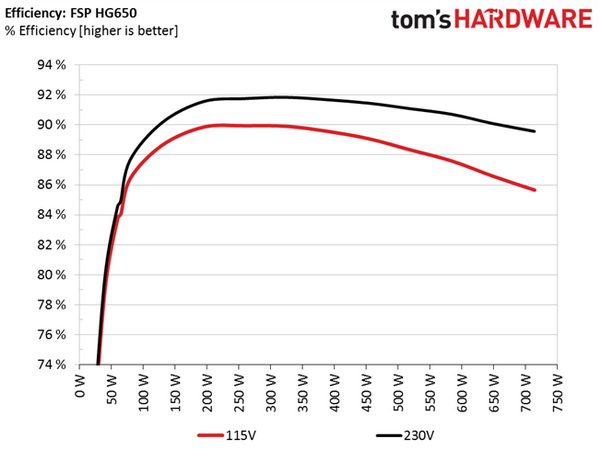
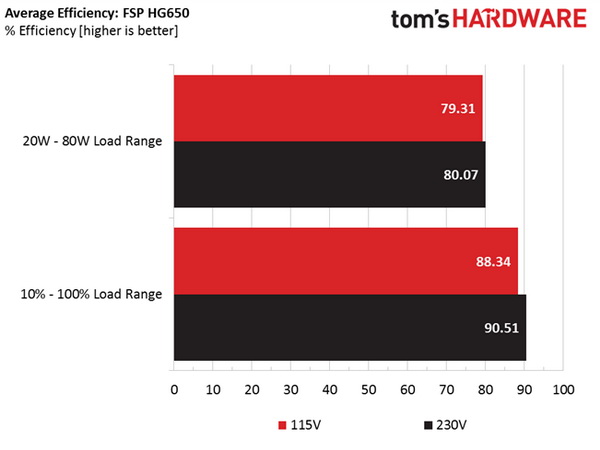
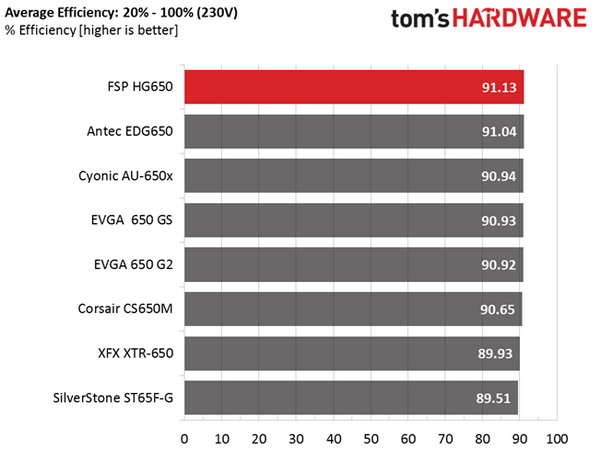
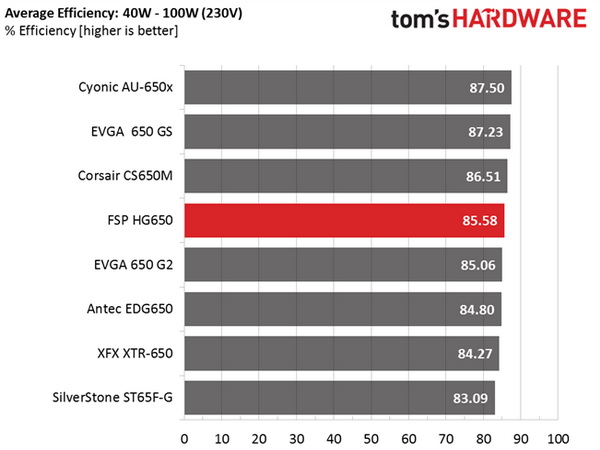
As the above graph shows, the efficiency difference between 230V and 115V is notable, especially under higher loads. Of course, this applies to most PSUs since the amperage with 230V is lower, reducing energy losses. But we're used to seeing a delta of around 1.5 percent. In this case, it exceeds 2 percent. With 230V, the HG650 is among the most efficient Gold-rated 650W PSUs we've tested.
Efficiency At Low Loads
In the following tests, we measure the efficiency of FSP's Hydro G 650 at loads significantly lower than 10 percent of its maximum capacity (the lowest load the 80 PLUS standard measures). The loads we dialed were 20, 40, 60 and 80W. This is important for representing when a PC is idle, with power-saving features turned on.
| Test # | 12V | 5V | 3.3V | 5VSB | DC/AC (Watts) | Efficiency | Fan Speed (RPM) | Fan Noise | PF/AC Volts |
|---|---|---|---|---|---|---|---|---|---|
| 1 | 1.190A | 0.480A | 0.468A | 0.190A | 19.60 | 68.10% | 0 | 0 dB(A) | 0.902 |
| 12.223V | 5.168V | 3.405V | 5.152V | 28.78 | 115.0V | ||||
| 2 | 2.430A | 0.957A | 0.970A | 0.385A | 39.70 | 78.96% | 0 | 0 dB(A) | 0.944 |
| 12.132V | 5.167V | 3.400V | 5.143V | 50.28 | 115.0V | ||||
| 3 | 3.669A | 1.455A | 1.470A | 5.133A | 59.89 | 83.76% | 0 | 0 dB(A) | 0.961 |
| 12.102V | 5.165V | 3.395V | 5.133V | 71.50 | 115.0V | ||||
| 4 | 4.888A | 1.931A | 1.945A | 0.780A | 79.73 | 86.43% | 0 | 0 dB(A) | 0.971 |
| 12.107V | 5.163V | 3.390V | 5.118V | 92.25 | 115.1V |
Efficiency is satisfactory under light loads. However, we would like to see greater than 70 percent efficiency in the 20W test.
It's worth mentioning that the PSU operates passively in these tests, even though the temperature inside of our hotbox is above 34 °C.
5VSB Efficiency
The ATX specification states that 5VSB standby supply efficiency should be as high as possible, recommending at least 50 percent with 100mA of load, 60 percent or higher with 250mA of load and 70 percent or higher with 1A or more of load.
Get Tom's Hardware's best news and in-depth reviews, straight to your inbox.
We take four measurements: one each at 100, 250 and 1000mA, and one with the full load the 5VSB rail can handle.
| Test # | 5VSB | DC/AC (Watts) | Efficiency | PF/AC Volts |
|---|---|---|---|---|
| 1 | 0.102A | 0.53 | 80.30% | 0.102 |
| 5.160V | 0.66 | 115.1V | ||
| 2 | 0.252A | 1.30 | 82.80% | 0.211 |
| 5.155V | 1.57 | 115.1V | ||
| 3 | 1.002A | 5.14 | 84.40% | 0.383 |
| 5.126V | 6.09 | 115.1V | ||
| 4 | 3.502A | 17.65 | 80.85% | 0.487 |
| 5.041V | 21.83 | 115.0V |
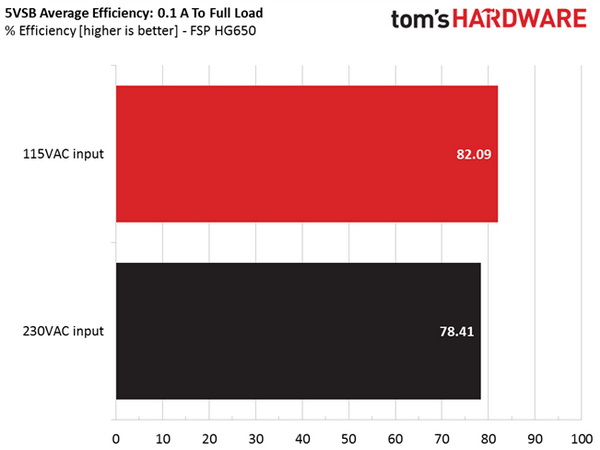
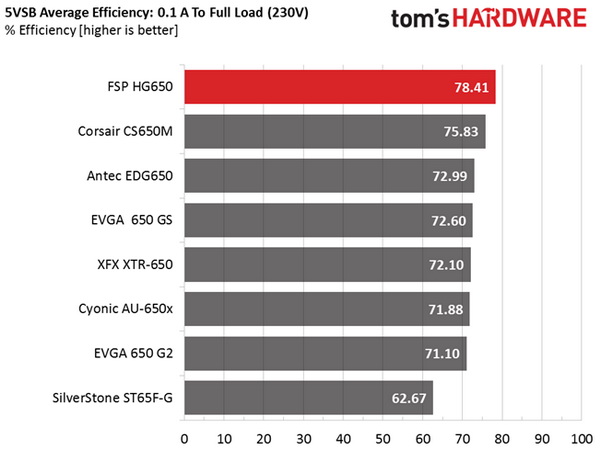
This is hands-down the most efficient 5VSB rail we have ever seen in a PSU, regardless of its efficiency rating. We're usually satisfied if efficiency goes above 80 percent in one test. However, the Hydro G 650 manages to score above 80 percent efficiency in all four of the tests. That's what we call amazing 5VSB performance!
Power Consumption In Idle And Standby
| Mode | 12V | 5V | 3.3V | 5VSB | Watts | PF/AC Volts |
|---|---|---|---|---|---|---|
| Idle | 12.244V | 5.173V | 3.412V | 5.161V | 8.15 | 0.613 |
| 115.1V | ||||||
| Standby | 0.05 | 0.007 | ||||
| 115.1V |
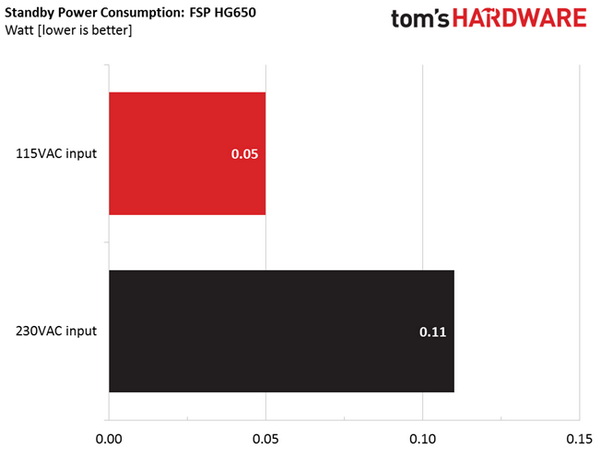
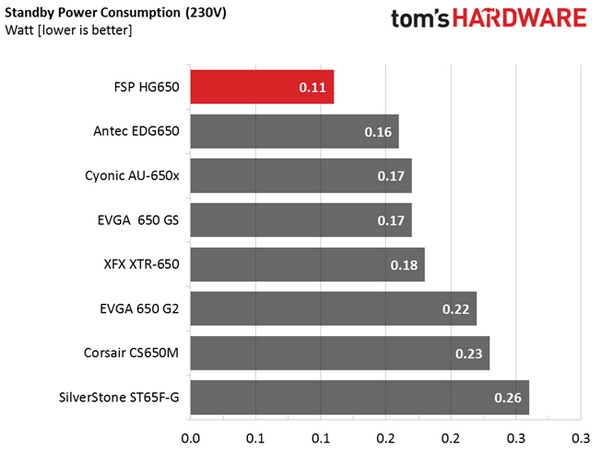
In the table above, you'll find the power consumption and voltage values of all rails (except -12V) when the PSU is idle (powered on, but without any load on its rails), and the power consumption when the PSU is in standby mode (without any load, at 5VSB).
At only 0.05W, phantom power is very low, which helps explain the 5VSB rail's high efficiency (particularly under light loads).
Fan RPM, Delta Temperature And Output Noise
Our mixed noise testing is described in detail here.
The first chart below illustrates the cooling fan's speed (in RPM), and the delta between input and output temperature. The results were obtained at 34 °C (93.2 °F) to 47 °C (116.6 °F) ambient temperature.
The next chart shows the cooling fan's speed (again in RPM) and output noise. We measured acoustics from one meter away, inside a small, custom-made anechoic chamber with internals completely covered in sound-proofing material (be quiet! Noise Absorber kit). Background noise inside the chamber was below 18 dB(A) during testing, and the results were obtained with the PSU operating at 34 °C (93.2 °F) to 47 °C (116.6 °F) ambient temperature.
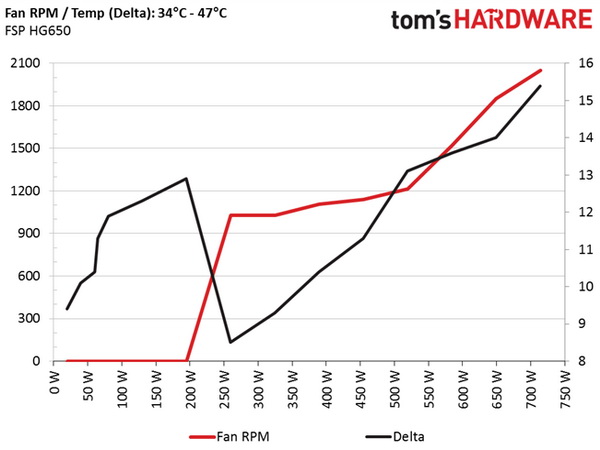

The following graph illustrates the fan's output noise over the entire operating range of the PSU. The same conditions of the above graph apply to our measurements, though the ambient temperature was between 28 °C (82.4 °F) and 30 °C (86 °F).
Up to around 130W, the Hydro G 650 operates in passive mode. And through most of its operating range, the PSU's noise is between 31-34 dB(A). Under loads exceeding 410W, the fan speeds up, and with more than 470-480W loads the noise reaches 37-40 dB(A). You can't call this a noisy PSU per se. However, there are competing products in this category that are quieter.
Current page: Efficiency, Temperature And Noise
Prev Page Load Regulation, Hold-Up Time And Inrush Current Next Page Cross-Load Tests And Infrared Images
Aris Mpitziopoulos is a contributing editor at Tom's Hardware, covering PSUs.
-
Onus I see a Performance Per Dollar chart, but so far I've not been able to find the price of this unit. What is it?Reply
-
Aris_Mp ReplyI see a Performance Per Dollar chart, but so far I've not been able to find the price of this unit. What is it?
It is 90 bucks
http://www.newegg.com/Product/Product.aspx?Item=N82E16817104200&nm_mc=AFC-C8Junction&cm_mmc=AFC-C8Junction-VigLink2-_-na-_-na-_-na&cm_sp=&AID=10446076&PID=3821802&SID=il40akd6as0035wt00053 -
mrjhh I remember FSP being an OEM for older computer vendors like DEC, so they definitely aren't a newcomer to the field. I'm glad to see they know how to build a modern supply.Reply -
Onus IMHO FSP has always had a solid but "middle-of-the-pack" reputation; not anybody's first choice, but a lot better than a lot of the junk being sold. Even their Raider units that got very critical reviews were acceptable as budget units in light use. In big box PCs, I'd certainly rather see FSP than HEC or Bestec.Reply
-
jeffunit I see "op amp amplifier" mentioned several times in the review.Reply
What is an "op amp amplifier"
Doesn't amp stand for amplifier in this context, which expands to op amplifier amplifier?
-
Odd naming scheme for a power supply. Hope it doesn't confuse anyone into thinking water goes well with it. :PReply
Always good to see some of the larger if less well known manufacturers putting out quality units. -
jeffunit ReplyWhat is an "op amp amplifier"
short for operational amplifier
op amp is short for operational amplifier.
op amp amplifier is short for operational amplifier amplifier.
You need to pay more attention to what is written. -
turkey3_scratch Good performing power supply. In terms of voltages and ripple, beats the EVGA GS. I would never hesitate to recommend this unit, if it is priced well of course, which it already is not.Reply
